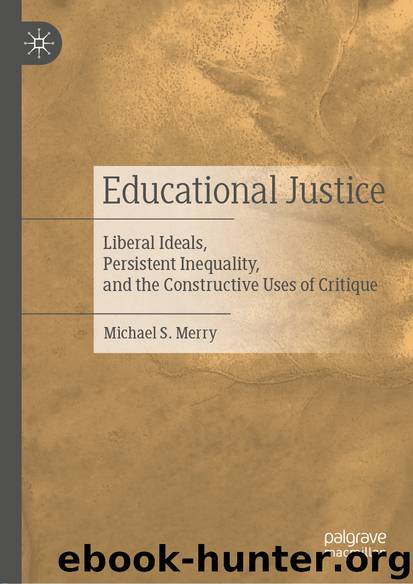Educational Justice by Michael S. Merry

Author:Michael S. Merry
Language: eng
Format: epub
ISBN: 9783030360238
Publisher: Springer International Publishing
Conclusions
In this chapter I have shown how diversity as proxy for educational justice relies on certain premises about how inequality is created and sustained, and about what a ‘good school’ might produce. With respect to prejudice reduction those premises suppose that diverse environments—and schools in particular—will produce citizens who are freer from prejudice, and more likely to seek and exercise the powers that attach to their social identities for the common good, rather than for their private advantage. With respect to social mobility those premises also maintain that, ideally, the benefits of diversity would flow equally toward all the involved parties, but they are willing to allow that the lion’s share of the benefits should flow to the disadvantaged. Seldom is the possibility entertained that in many cases the benefits of increasing diversity might, in fact, flow mostly toward those already most advantaged. Concerning academics, the preoccupation for many diversity scholars is with segregation and the achievement gap, on the concomitant assumption that the one causes the other. There is, however, no clear evidence of how the causation runs, or even if causation operates at all in this complex system. Much more needs to be determined—often on a case by case basis—about the presence of enabling conditions: adequate nutrition, family structure, the school climate, peer groups, curriculum options, mentoring programs, grouping practices, teacher quality and expectations, neighborhood characteristics, etc. than a simple ethnic or socioeconomic pupil ratio will ever be able to tell us.
By way of critique, and continuing what I began in the previous two chapters, I have documented a number of serious problems with the diversity thesis. These include an unwillingness to take seriously the structural features of mixed school environments that are persistently deleterious to students of poverty and students from stigmatized ethnic and social class backgrounds. They also include an unwillingness to accept the legal frameworks within which basic freedoms operate, including the choice to live where one chooses and associate with others with whom one may share things in common. Diversity advocates also continue to hold out for an unlikely reversal of legal proscription of race/ethnicity-based preferences that have historically served as the mechanism to produce diversity where ‘naturally’ there is little. With good intentions and the conviction that they are fighting the good fight, many pro-diversity advocates often not only remain unaware of how ‘exposure’ chiefly benefits the advantaged, too often they proceed without heeding what members of minority groups themselves care about or may have reason to value. Accordingly, advocates of educational equality bent on disrupting minority concentrations tend to be both blind to the prejudice implied by their beliefs about the intrinsic harms of minority spatial concentrations, as well as insensitive to the place attachments and community bonds many members of minority groups cherish.44
None of what I have argued should be interpreted to mean that diversity-promoting efforts that aim to foster mutual understanding and shared responsibility are unwise or beyond the realm of possibility. But the point I have tried to drive
Download
This site does not store any files on its server. We only index and link to content provided by other sites. Please contact the content providers to delete copyright contents if any and email us, we'll remove relevant links or contents immediately.
| Administration | Assessment |
| Educational Psychology | Experimental Methods |
| History | Language Experience Approach |
| Philosophy & Social Aspects | Reform & Policy |
| Research |
The Art of Coaching Workbook by Elena Aguilar(50962)
Trainspotting by Irvine Welsh(21516)
Twilight of the Idols With the Antichrist and Ecce Homo by Friedrich Nietzsche(18501)
Fangirl by Rainbow Rowell(9093)
Periodization Training for Sports by Tudor Bompa(8167)
Change Your Questions, Change Your Life by Marilee Adams(7633)
This Is How You Lose Her by Junot Diaz(6777)
Asking the Right Questions: A Guide to Critical Thinking by M. Neil Browne & Stuart M. Keeley(5629)
Grit by Angela Duckworth(5512)
Red Sparrow by Jason Matthews(5389)
Paper Towns by Green John(5086)
Room 212 by Kate Stewart(5034)
Ken Follett - World without end by Ken Follett(4643)
Housekeeping by Marilynne Robinson(4328)
The Sports Rules Book by Human Kinetics(4288)
Double Down (Diary of a Wimpy Kid Book 11) by Jeff Kinney(4204)
Papillon (English) by Henri Charrière(4195)
The Motorcycle Diaries by Ernesto Che Guevara(4009)
Exercise Technique Manual for Resistance Training by National Strength & Conditioning Association(3954)
